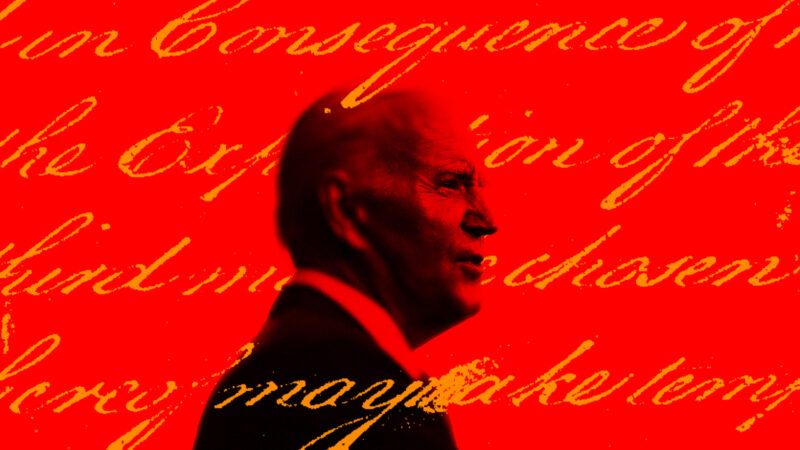Biden's Proposed Assault Weapon Ban Is Unconstitutional, Unlikely, and Ineffectual
As usual, Biden's gun policy proposals bump up against reality.

In his State of the Union address last night, President Joe Biden repeated his desire for a new assault weapon ban. "In 10 years that ban was law, mass shootings went down," he insisted. "After we let it expire in a Republican administration, mass shootings tripled." He is referring to a long-sunsetted ban on certain varieties of semiautomatic rifles in effect from 1994 to 2004.
As usual with talk of "assault weapons," the definitions of what weapons he's targeting are both vague and pointless. Biden himself has admitted that weapons of the same level of potential danger to others when misused by criminals will remain legal under any conceivable Democratic plan to institute a ban on new sales of them moving forward. (His plan also involves requiring those who already legally own such weapons—however the government defines them—to register them, which experience shows will also be pointless except in creating a huge class of "criminals" who have never harmed anyone.)
As usual, Biden and his party are aiming at a self-defense and leisure choice of millions of Americans, who never have and never will harm anyone unjustly with their weapons, to target a very small portion of any perceived gun violence crisis.
In 2021, and that year was perfectly typical in this regard, according to National Incident-Based Reporting System (NIBRS) data, rifles of all sorts were used in 4.9 percent (or 620) of all homicide offenses that involved firearms and 4.7 percent (or 11,995) of all assault offenses that involved firearms. In terms of homicides, for comparison of the nature of the crisis, motor vehicles/vessels were far more fatal in 2021 to Americans than rifles of any sort, with 951 homicides involving them.
Biden's assertion about the effectiveness of the old ban, and what has happened since then, is also off. Data gathered by the Marshall Project, which defines a "mass shooting" as an event "in which a gunman slaughters four or more strangers in a public place," suggest that Biden was wrong about mass shootings going down during the initial ban from 1994 to 2004.
The Marshall Project divides its analysis into five-year periods so that no one-year outlier muddles the matter. That analysis found that in every five-year period during which the original ban was partly or totally in effect, mass shooting incidents were higher than in the two five-year periods prior to the first ban. When it comes to casualties, the five-year period fully covered by the ban (1997–2001) saw more mass shooting casualties than 1982–86 (25 percent more) or 1987–91 (34 percent more).
To give Biden some credit, the last five-year period for which we have solid data, 2017–21, did see more mass shooting incidents than during the 1994–2004 period when the older assault weapon ban was in place. Still, the rise in such incidents was 50 percent (compared to the only five-year period in the Marshall Project analysis completely covered by the old ban), not the "triple" Biden stated. If we grant that Biden was speaking clumsily and meant to say that mass shooting fatalities "tripled," he's closer to correct. According to the Marshall Project data, fatalities from mass shootings increased 156 percent from 1997 to 2001 (again, the only five-year period in its analysis completely covered by the old ban) to 2017–21.
But, of course, the old "ban" did not eliminate mass ownership and access to existing weapons. The huge rise in mass shooting casualties, meanwhile, is largely a phenomenon of the past five years, casting doubt on any reliable causality across the nation and across time linking Americans' ability to buy new "assault weapons" and increased casualties of gun violence. Indeed, digging into the best relevant social science related to assault weapons and mass shootings, the RAND Corporation, in a paper updated last month, concluded that given "our assessment of these findings and the relative strengths of these studies, we find inconclusive evidence for the effect of assault weapon bans on mass shootings" (emphasis theirs).
The politics of Biden or the Democratic Party getting anywhere with such a new ban are highly iffy. The constitutionality of such a ban on a commonly and historically owned weapon capable of use for self-defense in the home is also highly questionable, especially given the Supreme Court's vacating in July 2022 of Bianchi v. Frosh, a 4th Circuit Court of Appeals decision upholding Maryland's state-level assault weapon ban.
The Supreme Court sent the case back to the 4th Circuit, insisting it must give "further consideration in light of New York State Rifle & Pistol Assn., Inc. v. Bruen." That's the case in which the Supreme Court rejected mere "interest-balancing" as sufficient to override Second Amendment rights. This new precedent ought to make lower courts take Americans' rights to possess arms more seriously than they reliably have in the decade and a half since the Heller decision made it clear the amendment covers at least the possession of commonly owned weapons for self-defense in the home.
